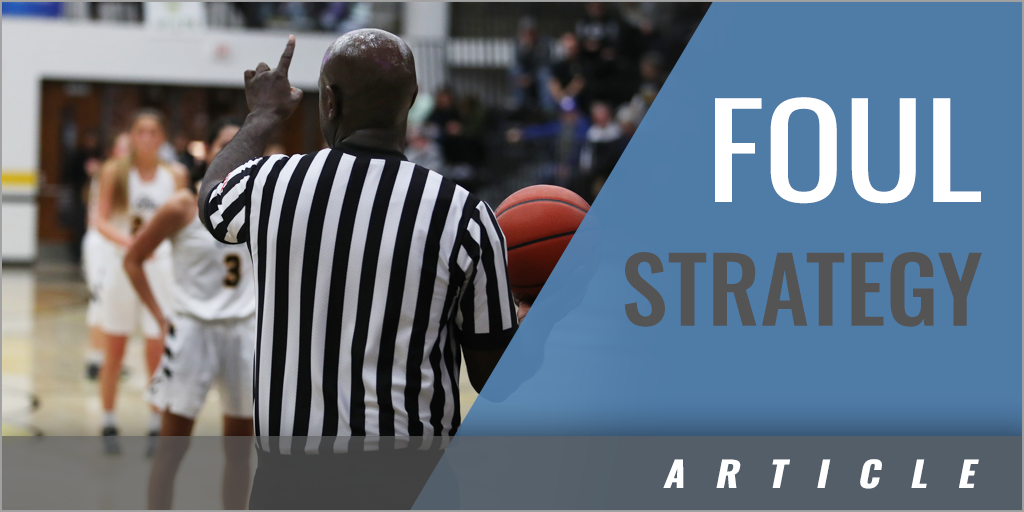|
By: Lee Rose Originally Published in: Winning Basketball Fundamentals Provided by: Human Kinetics Fouling is a fundamental component of basketball. Coaches and players must be on the same page and share the same viewpoint when it comes to when to foul and when not to foul. In chapter 5, "Offensive Priorities," we discussed the importance of free throws, citing how many games are determined by an open free shot (chapter 5). The free-throw figures included the entire game, not just end-of-game free throws. All free throws are important, so minimizing fouls and keeping teams out of the bonus is good strategy. Another important fundamental to keep in mind is never to foul a jump shooter. Why? You might be giving up a 4- or 6-point play if the shooter misses the free throw and his team captures the rebound to hit another three-pointer. Chapter 9, "Tactics for Special Situations," includes a thorough discussion of creating a foul policy that goes hand in hand with fouling strategies (chapter 9). Players must consciously limit their number of fouls, especially early in games. Players need to understand that the quickest way to reduce playing time is to pick up useless fouls. But fouling is advantageous at times, and knowing who, how, and when to foul is crucial. Each foul should be a smart play that does not penalize the team. Players must learn and practice proper fouling techniques so that they conform to the rules. Coaches must instruct players how to give a foul to avoid intentional two-shot fouls. For instance, if your opponent is holding the ball and statistics tell you their ball handlers are poor at the free-throw line, then fouling them might just keep you in the game. Taking away a driving layup and making an opponent hit two 15-foot (4.5 m) shots is defined by some as fouling for profit. (On the other hand, the offensive team trying to control the game must keep the ball in the hands of their best free-throw shooters. To do this, they might have to substitute to get their best free-throw shooters into the game.) Following 26 years of college coaching on through a 22-year tenure in the NBA, I encountered a number of differences between the various levels of coaching regarding defense in close games. Having worked with eight NBA head coaches, I found that they preferred to go man-to-man in game-ending situations where they had a 3-point lead with less than 10 seconds to play. In the college game, which doesn't have as many accomplished three-point shooters, coaches were prone to trap and zone. In either case, the rule of thumb was not to foul. Following is a situation in which the defense failed to execute. The players may have been told to foul or to contain the ball handler, but neither occurred, and it almost cost Florida the game. Early in February 2011, the University of Florida had a 3-point lead with 6 seconds on the clock. Their opponent had the ball out of bounds with 94 feet (28.7 m) to navigate. Florida applied token pressure on the inbounds pass, but the opposing guard caught the pass in full stride and the defender on the ball was suddenly two steps behind. The guard dribbled straight to the top of the key and hit an open three-pointer to send the game into overtime (which Florida went on to win 65-61). Applying token pressure on the offensive guards to eliminate rolling the ball up the floor is a good strategy, but hard pressure that permits a quick ball handler to beat the defender and get an open look is certainly a bad mistake. But this is exactly what happened here. Did Florida intend to foul? Did they have a foul to give? Good questions. The only way to prepare for this kind of situation is through practice. End-of-Game Decisions Planning and practicing for late-game situations is important for both offense and defense. Here are two NBA illustrations in which input would have been extremely helpful. These two examples illustrate the complexities and difficulties that teams encounter. How a team defends a situation usually goes back to one of two theories. Theory 1 says do not let the opponent's star player beat you; make him give up the ball. Theory 2 says to play your opponent tight and make their star hit the shot. In the second situation, as you will see, a major miscalculation occurred. Situation 1 In game 2 of the 2011 NBA Finals, Dallas beat Miami in Florida, coming back from a 15-point fourth-quarter deficit to tie the score. Here was the play: With 24.5 seconds remaining, the score was tied 93-93. Dallas had the ball out of bounds on the right side of the court, free-throw line extended. The inbounds pass went to Jason Kidd in the middle of the court. Kidd dribbled toward the sideline as Jason Terry set a pin-down screen for Nowitzki, Bosh defending. Nowitzki caught Kidd's pass slightly to the left of the free-throw lane line that runs from under the basket toward midcourt. Nowitzki was not quite straight on the basket upon receiving the ball. He made a great fake to the right, spun right to left, made a hesitation move that fooled Bosh, and drove left for an open layup to win the game with 3.6 seconds left. No defender rotated to help. Five defensive ramifications to consider: Could Miami have doubled-teamed Nowitzki? Yes. When was the best time for Miami to double-team Nowitzki? When he made his spin move. Was there an opportunity to foul Nowitzki on his spin? Yes. So why didn't Miami foul? Did they fear that he would hit two free throws? Dallas was not in the penalty. Regardless of who drew the assignment to guard Nowitzki, did everyone know that Bosh needed help? They should have! Situation 2 In an NBA playoff situation when I was an assistant coach, we were down 2 points with 26 seconds left to play. Our opponent had the ball in the front court, side out of bounds. All we had to do was get one stop, call a time-out, advance the ball, and get a good shot to tie the game. We had many defensive options: We could put pressure on the inbounds pass by putting a big man on the ball. We could trap the player receiving the inbounds pass with our defender on the inbounds passer. We could set up in a no-gamble defense, a 1-3-1 trap, double teaming on the first pass. We could run and jump, forcing action. But rather than take any of those options, our defensive assignment was to play straight-up man-to-man with no gambling and let the clock tick down. We were not supposed to foul, and after they took the last shot, we were to rebound, call time-out (there should be about three seconds left), advance the ball, run our play, and look to tie the game. Discussing various options with your assistants is always a good policy, to make sure that all your bases are covered. This approach is especially relevant in the NBA, which has a 24-second shot clock and different rules that apply to advancing the ball. Unfortunately, this discussion did not take place in this game. The plan backfired right from the get-go. The ball was inbounded to a crafty veteran point guard, Sam Cassell, who went to the middle of the court and began dribbling. With token pressure on him, we watched as the seconds ticked off. When the shot clock got to 0:03, Cassell made a quick move and shot the ball just as the shot clock expired, leaving 0:02 on the game clock. The ball hit the back of the rim and bounded high toward the sideline and went out of bounds as time expired. Needless to say, after the game, our locker room was very quiet. Coaches and players must practice situations and have specific plays for when they are down 1, 2, and 3 points, especially with 26, 10, 5, 3, and fewer seconds to get a good shot. In like manner, when a team is 1, 2, and 3 points up, they must have good plays for getting the ball inbounds. End-game strategy is vital, and only practice prepares a team properly. |






